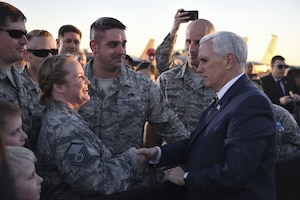By Brenda Law and Cori Fleser U.S. Africa Command
STUTTGART, Germany, Jan. 12, 2018 — U.S. Africa Command has
developed a new tool designed to measure progress in advancing women, peace and
security as part of its security cooperation effort.
The WPS Security Force Assistance assessment tool
establishes criteria to help Africom have a more informed understanding of how
an African partner nation implements WPS within its capacity and capability
building activities.
The SFA assessment tool is the brainchild of Africom’s
gender advisor, Cori Fleser.
“In my role as the gender advisor, I am responsible for
providing recommendations to staff at the command for implementing WPS within
our security cooperation activities,” said Fleser. “I developed this tool as a
method for informing my understanding to provide more tailored recommendations
into that annual planning process.”
With the Women, Peace and Security Act of 2017 signed into
U.S. law in October, Africom looked for new and innovative ways to integrate
women, peace and security into one of its core mission areas: security
cooperation.
Since 2011, the command has worked to integrate the mandate
in its activities with African security forces. Annual training courses
sponsored by Africom and conducted for African partners consistently have only
male participants. Consequently, Africom saw the need to develop specific
training opportunities specifically for women from African militaries. Beyond
such skilled areas as communications and intelligence, the command has cohosted
workshops and seminars on gender integration, the role of women in peacekeeping
operations and responding to gender-based violence.
Despite these successes, integrating women, peace and
security into existing military planning, execution, and assessment processes,
such as those for security cooperation, has been more of a challenge, which
inspired Fleser to develop the SFA assessment tool.
Assessing Women, Peace, Security Implementation
Informed by the Defense Department’s Implementation Guide
for Women, Peace and Security, the tool defines women, peace and
security-related criteria within DoD’s doctrinally defined security force
functions and identifies proxy indicators measured in data sets and global
indices that can be used to make an informed assessment of that specific
criteria.
The tool leverages open source data sets from international
organizations such as the United Nations, World Bank, and World Health
Organization, and uses indicators from global indices, such as the Fragile
States Index and Women, Peace and Security Index.
The tool provides a rationale for why the command can
confidently use those proxy indicators to assess the women, peace, and security
criteria in lieu of having access to a more preferred metric. The assessment of
these proxy indicators can provide an understanding of cross-sectoral gender
dynamics within an African partner nation and its security forces and
institutions, allowing for tailored approaches to working on women, peace, and
security implementation through security cooperation activities.
A Step in the Right Direction
While there is utility in this new tool, like many analytic
tools, Fleser acknowledges that it has its limitations. “It is important to
remember that proxy indicators are an indirect measurement,” she cautions, “and
they do not give us the full picture of how our partners are implementing the
women, peace, and security mandate within their security sectors. They will,
however, point us in a direction that is useful to security cooperation
planning.”
The WPS criteria established do not represent an exhaustive
list of criteria necessary for implementation but allows the command to work
together with African partners to identify new criteria for advancing the WPS
mandate through security cooperation activities. “Now the command has an
initial set of criteria that tells us what WPS looks like within our
doctrinally defined security force assistance categories,” Fleser said.
The SFA assessment tool advances the command’s
implementation of the WPS mandate in several ways. First, it introduces
quantitative data to complement the qualitative data that currently informs the
inclusion of WPS pillars in security cooperation planning. Second, it provides
security cooperation planners with a defined set of WPA criteria that nest
within an annual process they already support, simplifying and clarifying WPS
implementation. Third, the tool supports one of the key principles underpinning
the mandate by including nontraditional security indicators and using them to
inform a uniquely military planning process.
"Although not perfect, the SFA assessment tool is
designed to facilitate better security cooperation planning and WPS
implementation," Fleser said. "It does not provide a binary good/bad
assessment of African partner nations. Rather, it enables the command to better
understand how gender influences the security sector using quantitative data to
support that analysis and opens the opportunities for working together with our
partner nations to advance a mandate critical to achieving our mutual security
objectives."









